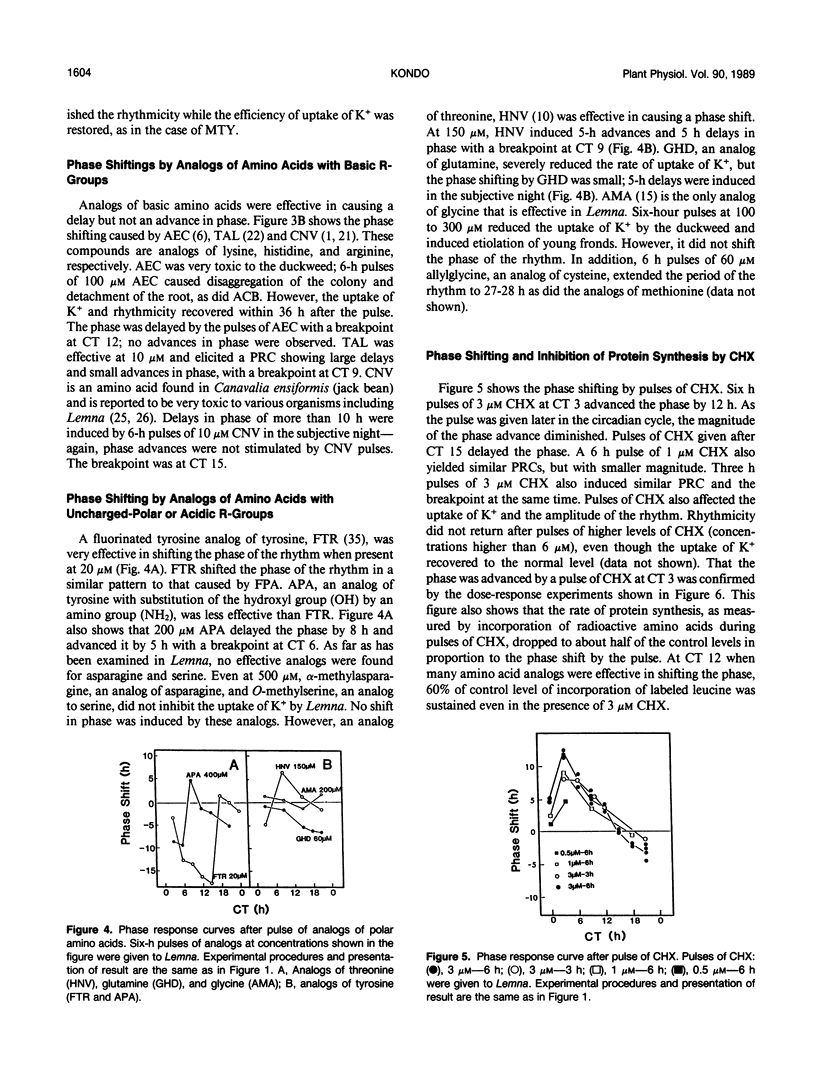Abstract
Phase shifts of the circadian rhythm of K+ uptake by Lemna gibba G3, caused by pulse administration of various amino acids analogs, were examined and compared. The various phase shifts were not due to any disturbance in the biosynthesis of amino acids, since the effective time of day and direction of the phase shift caused by analogs were not correlated with the standard amino acid which was modified. Effective analogs could be classified into three groups. The first group was effective during the middle subjective day and caused both advances and delays in phase. The second group was effective early in the subjective night, causing large delays and small phase advance. Analogs in the third group shifted the phase as did cycloheximide and were effective at the subjective dawn. Since the analogs of the third group were known to inhibit protein synthesis, it is likely that they shift the phase by lowering the level of some protein(s) important for the clock. By contrast, since the analogs in groups 1 and 2 are known to generate abnormal proteins, the different phase-shifting patterns caused by analogs in groups 1 and 2 suggest that at least two other proteins are important for the circadian timing loop. The amino acid analogs shift the phase as a result of their incorporation into these proteins instead of the standard amino acid. This probably alters the structure and/or activities of these proteins.
Full text
PDF








Selected References
These references are in PubMed. This may not be the complete list of references from this article.
- Attias J., Schlesinger M. J., Schlesinger S. The effect of amino acid analogues on alkaline phosphatase formation in Escherichia coli K-12. IV. Substitution of canavanine for arginine. J Biol Chem. 1969 Jul 25;244(14):3810–3817. [PubMed] [Google Scholar]
- Dunlap J. C., Feldman J. F. On the role of protein synthesis in the circadian clock of Neurospora crassa. Proc Natl Acad Sci U S A. 1988 Feb;85(4):1096–1100. doi: 10.1073/pnas.85.4.1096. [DOI] [PMC free article] [PubMed] [Google Scholar]
- Freundlich M. Valyl-Transfer RNA: Role in Repression of the Isoleucine-Valine Enzymes in Escherichia coli. Science. 1967 Aug 18;157(3790):823–825. doi: 10.1126/science.157.3790.823-a. [DOI] [PubMed] [Google Scholar]
- Goldberg A. L. Degradation of abnormal proteins in Escherichia coli (protein breakdown-protein structure-mistranslation-amino acid analogs-puromycin). Proc Natl Acad Sci U S A. 1972 Feb;69(2):422–426. doi: 10.1073/pnas.69.2.422. [DOI] [PMC free article] [PubMed] [Google Scholar]
- HASTINGS J. W. Biochemical aspects of rhythms: phase shifting by chemicals. Cold Spring Harb Symp Quant Biol. 1960;25:131–143. doi: 10.1101/sqb.1960.025.01.012. [DOI] [PubMed] [Google Scholar]
- Hortin G., Boime I. Miscleavage at the presequence of rat preprolactin synthesized in pituitary cells incubated with a threonine analog. Cell. 1981 May;24(2):453–461. doi: 10.1016/0092-8674(81)90336-6. [DOI] [PubMed] [Google Scholar]
- Kisumi M., Komatsubara S., Sugiura M., Chibata I. Isoleucine hydroxamate, an isoleucine antagonist. J Bacteriol. 1971 Sep;107(3):741–745. doi: 10.1128/jb.107.3.741-745.1971. [DOI] [PMC free article] [PubMed] [Google Scholar]
- Kondo T. Phase Shift in the Potassium Uptake Rhythm of the Duckweed Lemna gibba G3 Caused by an Azide Pulse. Plant Physiol. 1983 Nov;73(3):605–608. doi: 10.1104/pp.73.3.605. [DOI] [PMC free article] [PubMed] [Google Scholar]
- Kondo T. Phase shift of the circadian rhythm of lemna caused by pulses of a leucine analog, trifluoroleucine. Plant Physiol. 1988 Nov;88(3):953–958. doi: 10.1104/pp.88.3.953. [DOI] [PMC free article] [PubMed] [Google Scholar]
- Nakashima H., Perlman J., Feldman J. F. Cycloheximide-induced phase shifting of circadian clock of Neurospora. Am J Physiol. 1981 Jul;241(1):R31–R35. doi: 10.1152/ajpregu.1981.241.1.R31. [DOI] [PubMed] [Google Scholar]
- Olesiak W., Ungar A., Johnson C. H., Hastings J. W. Are protein synthesis inhibition and phase shifting of the circadian clock in Gonyaulax correlated? J Biol Rhythms. 1987 Summer;2(2):121–138. doi: 10.1177/074873048700200204. [DOI] [PubMed] [Google Scholar]
- Pine M. J. Response of intracellular proteolysis to alteration of bacterial protein and the implications in metabolic regulation. J Bacteriol. 1967 May;93(5):1527–1533. doi: 10.1128/jb.93.5.1527-1533.1967. [DOI] [PMC free article] [PubMed] [Google Scholar]
- Pines M., Rosenthal G. A., Applebaum S. W. In vitro incorporation of L-canavanine into vitellogenin of the fat body of the migratory locust Locusta migratoria migratorioides. Proc Natl Acad Sci U S A. 1981 Sep;78(9):5480–5483. doi: 10.1073/pnas.78.9.5480. [DOI] [PMC free article] [PubMed] [Google Scholar]
- Prouty W. F., Karnovsky M. J., Goldberg A. L. Degradation of abnormal proteins in Escherichia coli. Formation of protein inclusions in cells exposed to amino acid analogs. J Biol Chem. 1975 Feb 10;250(3):1112–1122. [PubMed] [Google Scholar]
- RENNERT O. M., ANKER H. S. ON THE INCORPORATION OF 5',5',5'-TRIFLUOROLEUCINE INTO PROTEINS OF E. COLI. Biochemistry. 1963 May-Jun;2:471–476. doi: 10.1021/bi00903a013. [DOI] [PubMed] [Google Scholar]
- RICHMOND M. H. Random replacement of phenylalanine by p-fluorophenylalanine in alkaline phosphatase(s) formed during biosynthesis by E. coli. J Mol Biol. 1963 Apr;6:284–294. doi: 10.1016/s0022-2836(63)80089-3. [DOI] [PubMed] [Google Scholar]
- Rosenthal G. A., Gulati D. K., Sabharwal P. S. Studies on the Growth Effects of the Canaline-Urea Cycle Amino Acids with Lemna minor L. Plant Physiol. 1975 Sep;56(3):420–424. doi: 10.1104/pp.56.3.420. [DOI] [PMC free article] [PubMed] [Google Scholar]
- Smulson M. E., Rabinovitz M., Breitman T. R. O-methylthreonine inhibition of growth and of threonine deaminase in Escherichia coli. J Bacteriol. 1967 Dec;94(6):1890–1895. doi: 10.1128/jb.94.6.1890-1895.1967. [DOI] [PMC free article] [PubMed] [Google Scholar]
- Takahashi J. S., Turek F. W. Anisomycin, an inhibitor of protein synthesis, perturbs the phase of a mammalian circadian pacemaker. Brain Res. 1987 Mar 3;405(1):199–203. doi: 10.1016/0006-8993(87)91010-9. [DOI] [PubMed] [Google Scholar]
- Walz B., Sweeney B. M. Kinetics of the cycloheximide-induced phase changes in the biological clock in Gonyaulax. Proc Natl Acad Sci U S A. 1979 Dec;76(12):6443–6447. doi: 10.1073/pnas.76.12.6443. [DOI] [PMC free article] [PubMed] [Google Scholar]
- Wheatley D. N. Biological and biochemical effects of phenylalanine analogs. Int Rev Cytol. 1978;55:109–169. doi: 10.1016/s0074-7696(08)61888-4. [DOI] [PubMed] [Google Scholar]
- Yeung S. J., Eskin A. Involvement of a specific protein in the regulation of a circadian rhythm in Aplysia eye. Proc Natl Acad Sci U S A. 1987 Jan;84(1):279–283. doi: 10.1073/pnas.84.1.279. [DOI] [PMC free article] [PubMed] [Google Scholar]


